How to repair the Do-it-yourself Pump repair: repairing popular breakdowns
Summer residents use the inexpensive submersible pump "Trickle" for more than half a century. Due to active use, a structurally simple device sometimes turns out to be faulty or does not work satisfactorily. In some cases, it is impossible to do without the participation of repair technicians, and more often you can repair the Brook pump yourself.
To do this, you need to understand the device and the principle of the pump, be patient and with the necessary set of tools. The recommendations presented in the article, illustrations and video guides will provide effective assistance.
The content of the article:
Characteristics and scope
The electric pump "Rucheek", manufactured by the Russian company OAO Livhydromash, belongs to the class of household vibration devices. It is designed to supply water from wells and water wellshaving an internal diameter of at least 10 cm. It can be used for work in open reservoirs, where it is able to transport water from a depth relating to the interval 1 - 40 m.
The maximum distance that the pump can transport water horizontally is 100 m. water intake point can be significantly removed from the consumer. The temperature of the pumped water is not more than + 35ºС. The trickle should not work in an aggressive environment and in water, including pollution greater than 0.001%.
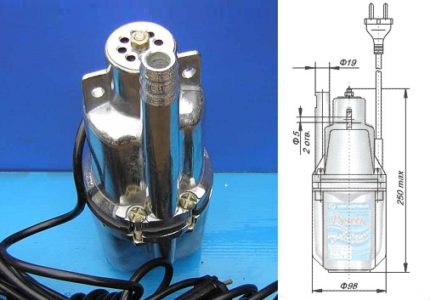
Technical characteristics of the vibration pump "Trickle":
- supply voltage - 220V;
- power - 3.4 W;
- maximum immersion depth - 3 m (with a low-production well, an increase in immersion depth up to 5 m is allowed);
- working pressure range - from 4 to 60 m;
- dimensions - 250x99 mm, weight - approximately 3.5 kg (depending on version).
The pump is equipped with a power cord from 10 to 40 m and a nylon cable for hanging the unit when installation in the well or well.
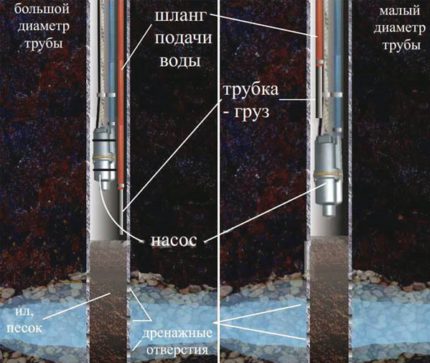
Of course, such a small pump cannot provide water supply of the entire country house with a lot of water consumers.
"Trickle" successfully serves to perform tasks such as:
- Water supply of a small country house with 1-2 points of water consumption.
- Water supply for the bath, watering the garden.
- Temporary replacement of the main pump in case of failure.
- In slowly filled water sources with a small flow rate;
- The first or periodic cleaning of the well;
- Filling the heating system.
Pump performance directly depends on the depth of the water source: the deeper it is, the higher the productivity of the unit.
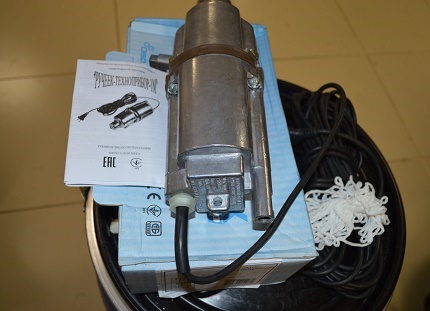
Device and principle of operation
Submersible trickle pump consists of the following parts: electric drive, vibrator and housing, which are interconnected by four screws. The electric drive of the unit includes a core with two coils and a power cord.
The vibrator consists of a shock absorber, a diaphragm, an emphasis, a coupling and a rod. An anchor is pressed into the bottom of the stem; a piston is attached to it at the top.
The pump casing is a casing, in the upper part of which there is a glass with holes for water inlet and a pipe that provides water outlet. The existing valve serves to open / close the inlet openings.
The pump pumps water through vibrations of the piston and armature. They are driven by an elastic shock absorber, which turns the alternating current received from the network into a uniform mechanical vibration.
The stem transmits the movement to the piston, which when vibrated creates a mini-hydraulic shock in the glass with holes. The valve closes at this moment, and the water is pushed into the outlet pipe.

Due to the fact that water intake takes place in the upper part of the unit, the system is cooled and it does not heat up during operation.
Another advantage of the pipe for water intake, located on top - the sludge from the bottom is not sucked in by the working body. As a result, the unit is much less likely to have a lower fence clogged with a muddy suspension, due to which the pump should be periodically disassembled and cleaned.
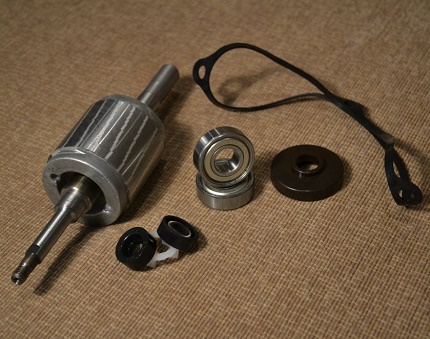
Setting the submersible pump “Trickle”
The trickle pump is considered reliable equipment. With proper operation and timely maintenance, it rarely breaks. In some cases, troubleshooting can be done by adjusting the pump.
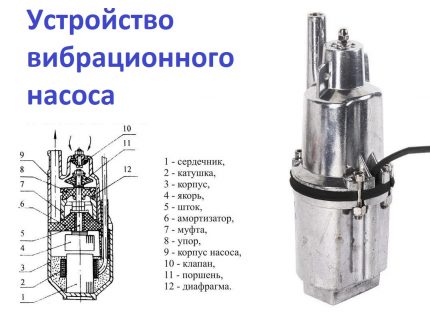
To do this, first of all, an idle or unstable pump must be removed from the well (well) and hang it without a hose in a container of water. Next, you need to connect the device to the network and check the voltage, it should be at least 200V.
If the voltage in the network corresponds to the norm, then turn off the pump, drain water from it and blow out the outlet.Purging can be done by mouth without using any special tools.
A correctly tuned trickle pump is blown without any problems, and if you blow it harder, you can feel the piston stroke inside. Air must also travel in the opposite direction. If this does not happen, then it is necessary to configure two parameters of the unit, having previously disassembled it.
Dismantling the domestic pump “Trickle” is carried out using a vise, which compresses the ledges on the housing, located next to the screws. The screws must be loosened gradually, in turn. At the first disassembly, it will not be out of place to replace the screws with similar screws with a head for a convenient hexagon, this will greatly facilitate assembly and disassembly during the next repair.

From the principle of operation of the pump "Trickle" described above, it follows that the two parameters are configured in the following order:
- Piston position adjustment. It should be parallel to the rest of the unit. The parallelism control is carried out using a caliper. Misalignment of the piston body can occur due to the gap between its metal sleeve and stem. To eliminate it, you need to wind the rod with foil until full parallelism is observed.
- Checking the coincidence of the axis of the rod and piston. When they are displaced, the inlet glass usually “fidgets” along the gasket. To eliminate it, it is necessary to disassemble and reassemble the assembly, temporarily securing the glass during assembly to the laying with adhesive tape pieces.
- Setting distance between piston and seat. It should be approximately 0.5 mm. Adjustment is made by changing the number of washers with a thickness of 0.5 mm, mounted on the rod. This indentation is necessary so that air during purging, and subsequently water, passes into the outlet pipe without obstruction, and when pressure increases, the outlet is blocked by a piston.
With an increase in the number of washers, the piston approaches the seat, therefore, when the mouth is purged, air will not pass. Only with suction in both cases should air circulate freely.
It happens that the piston rod turns out to be bent. Fix it is unlikely to succeed. However, if this did not affect the operation of the unit, you can slightly correct the position by turning the gasket 180º relative to the rod.
A properly configured and assembled vibration pump without a hose when immersed in a container with water should give a pressure of 0.2-0.3 m and work without interruption at normal voltage in the mains 220V plus / minus 10V. If, after adjustment, the equipment does not work or does not work satisfactorily, it is necessary to establish the cause of the breakdown and eliminate it.

Common faults and solutions
Subject to the operating rules recommended by the manufacturer, the Trickle pump rarely breaks. Most of the malfunctions are associated with a violation of the rules of operation of the equipment, they occur after 3-4 years of operation without the necessary care.
In order to prevent clogging of the engine and the intake pipe of the vibratory unit, it is necessary to carefully monitor the condition of the water source, to timely remove sludge and sand deposits from the walls and bottom. Required pump a new well before commissioning.
Please note: if your pump is under warranty or after-sales service, it is not possible to independently open the case and repair work! In this case, you should contact the service center or the seller of the equipment.
The following photo selection will help those who wish to restore the device’s performance with their own hands:
Consider the most common breakdowns of the domestic pump "Trickle", not associated with factory defects and occurring during operation.
# 1: Replacing a worn and torn valve
The ingress of small stones and other foreign bodies often occurs when using a pump to pump drainage water from the basement, to clean the well, etc. To avoid this, it is necessary to install an additional fine mesh filter, which is pulled onto the water intake part of the pump, where water is sucked in.
If a foreign body gets inside the mechanism, then most likely it will go through the built-in filter and get stuck at the valve, as the valve is made of waterproof rubber, then after a while it will break.
A sign of rupture or excessive valve wear is a significant and increasing decrease in performance. Pump humming when a valve is damaged usually remains normal.
In this case, it is not difficult to repair the pump; it is enough to replace the rubber valve, having previously disassembled the pump. Some users claim that instead of a faulty valve, you can use a cork from a medical bottle.
This is not recommended, as this design will not last long, it is best to use a special repair kit for the vibration pump.
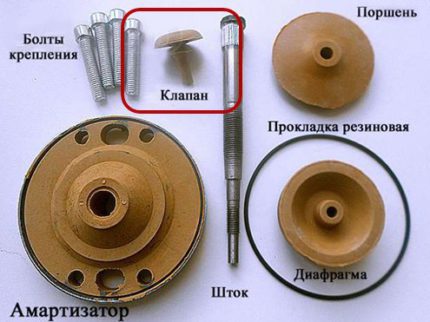
# 2: Exfoliating electromagnet peeling
Electromagnet separation occurs when a running pump comes into contact with the walls of a well, well, or water tank. Such strokes will be synchronous, and their number exceeds 100 beats per minute.
The body of the unit does not withstand such a load and begins to heat up, which leads to delamination of the fill from the electromagnet (core). The same thing happens if the pump runs dry for more than 5 seconds without water.
A sign of detachment of the magnetic part is overheating of the pump and excessively intense vibration. To resolve this problem, the following steps must be taken:
- Turn off the pump and raise it to the surface.
- To disassemble, separating the electrical part and get the electromagnet with coils. To do this, use a grinder to cut shallow 1-2 mm grooves around the magnet
- Cut through several similar grooves on the inside of the housing.
- Lubricate the element with glue, then with sealant, which is used for auto glass.
- Mount the electromagnetic part in the housing and wait until it solidifies.
Reassembling the pump is permitted only after the adhesive has completely hardened.
# 3: Prevention of depressurization of the housing
Depressurization of the housing leads to noticeable interruptions in the supply of water. To prevent it, you need to choose the right dimensions pump for a specific well or well. The unit must not come into contact with the walls during operation.
Diagnosing Symptom Problems
Do not let the pump run dry! To prevent such situations, the system is supplemented with an automation unit or a dry-running sensor.
It is also required to regularly conduct routine inspections of the well, in the event of friction against the walls, it is necessary to immediately raise the pump to the surface and eliminate the cause of friction by moving the pump.

Reason # 1: The pump buzzes and does not pump
This is the most common complaint of the owners of the pumps "Trickle": the unit is buzzing, but it does not pump water and the case does not heat up. The causes of the malfunction can be several:
- Loose piston fasteners. This is due to vibration and, in principle, is inevitable after 2-3 years of operation. The use of additional washers will help extend the life of the mount. Repair in this case consists in tightening the piston nut or replacing it.
- Valve damage. To fix the problem, it is necessary to disassemble the pump and inspect the valve. It can be deformed or torn by fine gravel or grains of sand falling into the pump. In this case, replacing the rubber valve with a new one will also help, but this replacement will have to be done regularly once every 1-2 years, depending on the intensity of the pump.
- Rubber piston wear. You can determine by reducing the volume of pumped water, accompanied by increased buzz of the pump. It is treated by replacing a damaged flexible part.
- Poor shock absorber mount. With this breakdown, the shock absorber does not fulfill its function, the rod hangs and the anchor knocks on the electromagnet. Repair - tightening and / or replacing shock absorber nuts.
- Broken or broken stem. Occurs due to intense mechanical stress. This is the most difficult case of failure. Repair consists in the complete replacement of a non-working part. In this case, it would be advisable to consider the option of buying a new domestic pump.
If you find that your “Trickle” is buzzing, but does not pump water, you must immediately disconnect it from the mains, raise it to the surface and look for the cause of the malfunction. In this case, the pump must not be left running!
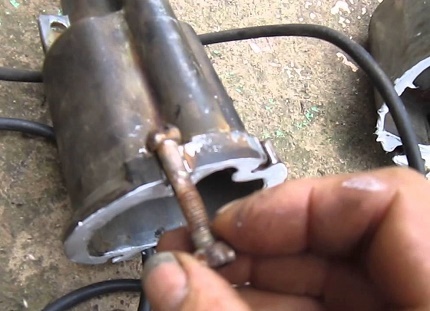
Reason # 2: The pump heats up and buzzes a lot
This malfunction is most often associated with the fact that the equipment worked without immersion in water. Brook like any other vibrating pump, has a design in which the cooling of all its elements occurs due to the liquid pumped by it.
If the water level drops or is absent, the unit stops cooling and overheats. Most often, in such conditions, the electromagnetic part fails: the winding of the electromagnet burns out and it completely loses its properties, which means it does not provide vibration.
It is difficult, but possible, to repair the electromagnet independently. For repair you will need the following tools and materials:
- copper wire for winding with a diameter of 65 microns;
- PVC tube with a diameter of 4 mm;
- rapid hardening epoxy;
- soldering iron and electric stove;
- winding machine;
- hammer, flat screwdriver;
- protective equipment: mask of the welder and mittens.
Repair work involving the use of a soldering iron and epoxy is best done in the open air. In no case do not inhale the fumes of the resin, they are toxic and have a very negative effect on the lungs! Work must be done with gloves, avoiding contact with the skin.
When repairing the electromagnetic part of the pump, an assistant who can hold the pump in his hands when removing the electromagnet from the coils will not be out of place.

Step-by-step repair instructions for the electromagnet of the submersible pump "Trickle":
- We disassemble the pump and remove the electromagnet with coils by heating the casing with an electric stove. The epoxy resin surrounding the electromagnet will become soft under the influence of temperature and the element can be easily reached by gently tapping the unit on a wooden deck.
- Until the epoxy has solidified, it is necessary to clean the inside of the pump from its remnants.
- We remove the electromagnet from the coils with a wooden block and a hammer. The assistant must hold the electromagnet in his hands, and you point the bar to the electromagnet and carefully knock it out, striking with a hammer on the bar. Why is an element necessary to keep? This will prevent split coils, as it is possible to better control the force of impact.
- We unwind the burned windings of the coils and clean the surviving parts of the remnants of the epoxy substance.
- Using a winding machine, wind the reel to get 8-10 layers, and fix the last layer with cotton tape. At the beginning of the winding, put on a PVC tube, and fix the coil frames on the core of the electromagnet.
- Strip the ends of the windings that are on the outside and solder with a soldering iron to obtain the desired connection. Bite off the excess winding.
- Route the cable into the pump housing through the seal to the place where the electromagnet will be installed. Cut the end of the cable into separate wiring and strip their ends.
- Twist the ends of the cable with the beginning of the windings of the electromagnet and coils and solder. Lower the electromagnet with coils into place, while removing excess cable. For a reliable landing of the electromagnet, use a hammer, delivering them accurate point blows through a wooden block.
- Clamp the body of the unit and align it using the building level. Stir the epoxy resin and fill it around the coil to the top edge of the electromagnet. We are waiting 10-15 minutes for the “epoxy” to fill all the voids.
It takes at least 24 hours to harden the resin. After this time, assemble the pump and try its work, immersing in a container of water.
Note that repairing an electromagnet is a time-consuming process. In most cases, it is more advisable to purchase a new “Trickle” pump, but if you have the time and desire, you can try to do it yourself in accordance with the step-by-step instructions.
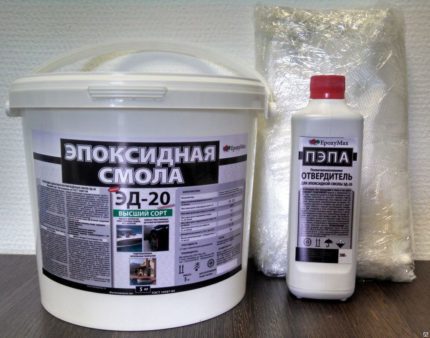
Reason # 3: The pump runs silently
The “trickle” is not the pump that works silently in good condition, so the lack of measured buzz should alert you no less than excessive noise.
With a decrease in noise level, it is always noticeably reduced water supply pressure. The reason for this malfunction is that the voltage in the mains has dropped below the minimum allowable limit, i.e. below 180V. With a voltage reduction of 10%, the pump performance decreases by 50%.
In this case, the pump must be disconnected from the power supply and measures must be taken to set the voltage to normal, for example, use a special stabilizer.
If the voltage in the mains is too high, the “Stream” pump does not turn on, becauseprotection is triggered.
Pump unit breakdown prevention
By observing the operating rules recommended by the manufacturers, you will minimize the risk of breakdown of pumping equipment, and it will serve you for many years.
Basic rules of operation:
- Do not allow the pump to run without water.
- Do not use the pump if there is an unstable voltage in the mains.
- Do not operate the pump with a damaged power cord or housing.
- Do not move the unit by the power cord.
- Do not pinch the hose to increase pressure.
- Do not pump water with dirt, impurities, garbage.
When installing the pump in the well, it is necessary to wear a protective ring made of rubber on it, which will protect the equipment from impacts on the walls.
Switching the unit on / off can only be done with a plug or a bipolar switch embedded in a fixed wiring system.

During the operation of the vibration pump "Trickle", it is necessary to timely conduct a preventive inspection and monitor the quality of the pumped water. If the water comes in dirty, then the pump must be turned off and its position relative to the bottom checked.
Conclusions and useful video on the topic
Video # 1. Repair of the pump “Cricket” - a complete analogue of “Brook”:
Video # 2. Visual demonstration of vibration pump repair:
Electric pump "Trickle" - a simple and reliable unit. In the event of a breakdown, it can be repaired with your own hands, significantly saving on repairs. But the best option is to prevent the pump from failing. It is not difficult to do this, it is necessary to carefully study the operating instructions and carry out timely maintenance and monitoring of equipment operation.
Have questions or want to share the experience gained during the summer vibrating pump? Please write comments. Post with your opinion and a photo on the topic.

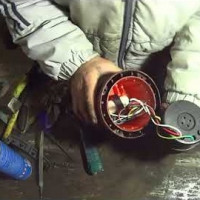 Do-it-yourself water pump repair: an overview of the most popular failures
Do-it-yourself water pump repair: an overview of the most popular failures  Do-it-yourself repair of the Aquarius pump: an overview of typical breakdowns and their elimination
Do-it-yourself repair of the Aquarius pump: an overview of typical breakdowns and their elimination 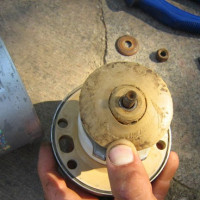 Do-it-yourself kid pump repair: an overview of the most popular failures
Do-it-yourself kid pump repair: an overview of the most popular failures 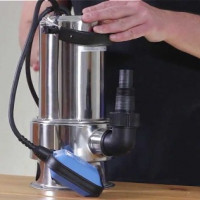 How to repair the drain pump yourself: an overview of frequent breakdowns
How to repair the drain pump yourself: an overview of frequent breakdowns 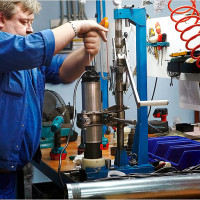 Repair the pump “Gnome”: an overview of popular breakdowns and how to fix them
Repair the pump “Gnome”: an overview of popular breakdowns and how to fix them 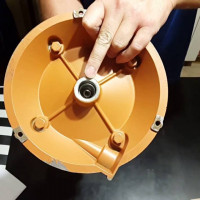 How to repair the Agidel pump: an overview of typical breakdowns and how to fix them
How to repair the Agidel pump: an overview of typical breakdowns and how to fix them  How much does it cost to connect gas to a private house: the price of organizing gas supply
How much does it cost to connect gas to a private house: the price of organizing gas supply  The best washing machines with dryer: model rating and customer tips
The best washing machines with dryer: model rating and customer tips  What is the color temperature of light and the nuances of choosing the temperature of the lamps to suit your needs
What is the color temperature of light and the nuances of choosing the temperature of the lamps to suit your needs  Replacement of a geyser in an apartment: replacement paperwork + basic norms and requirements
Replacement of a geyser in an apartment: replacement paperwork + basic norms and requirements
In the video, the guy recommends putting bolts from the bottom. This is not worth doing. Since in case of pump immersion in the well (basically a pipe goes slightly larger than the pump diameter), when the bolts are unscrewed, the nuts fall between the pump and the pipe wall and the pump is “buried” in most cases.
Practical advice for those who will disassemble the pump for repair. There is nothing difficult in repairing this simple pump for a person with hands, but the main thing is not to confuse the assembly sequence. Therefore, do not repair on your knees! Put all the details on the table and disassemble by laying out all the details on the table one after another. Reassemble in the reverse order by replacing a failed part. I had the sad experience of changing the bearing, now only like that.
In my country house I use “Trickle” only for pumping water from the sewer well, into which the washing and dishwasher drain water. Thank God, it has been working for several years. It broke only once when it sucked a piece of polyethylene, it is unclear how it got into the water. I then took it apart, cleaned it, put a fine mesh on top of it and there were no more problems.The pump is quite inexpensive, but it performs its job pretty well. The most important thing is to periodically get it out and clean it.
Simple curiosity. To quickly replace quickly wearing parts, manufacturers of vibration pumps produce repair kits that include a complete set of necessary spare parts. And why the anchor, bearings, oil seals for this pump? )))